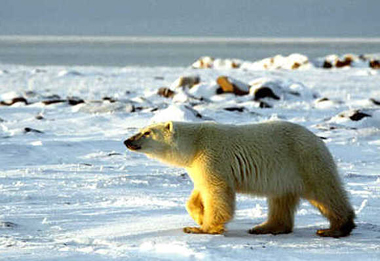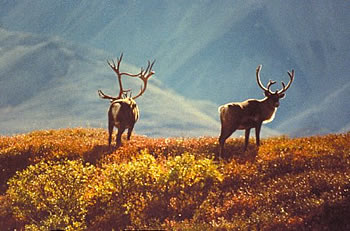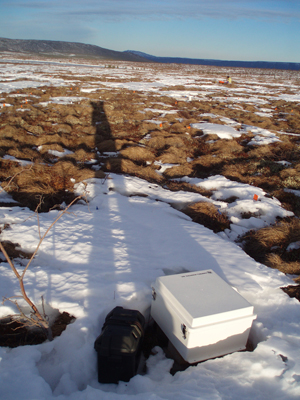There is twice as much carbon in Arctic soils and permafrost than there is in the atmosphere. As a warmer world causes permafrost like this to thaw, carbon decomposes and is released to the atmosphere.
Click on image for full size
Courtesy of Ted Schuur
Arctic Tundra May Contribute to Warmer World
News story originally written on May 27, 2009
Global warming is causing frozen soil to thaw in the Arctic. A team of scientists has been looking at how this is changing the tundra and how thawing soils are affecting greenhouse gases in the atmosphere.
There is a large amount of carbon in the frozen soil. As the soil thaws, carbon can be released into the atmosphere, increasing the amount of greenhouse gases, which causes more warming.
Carbon moves around the Earth in the carbon cycle. The researchers wondered how carbon that has been in the frozen soils for hundreds to thousands of years, moved through the carbon cycle. They used radiocarbon dating to figure out where the carbon goes as the soil thaws.
Their results showed that when soil first begins to thaw, more plants are able to grow. The plants remove carbon from the atmosphere through the process of photosynthesis. This makes the amount of carbon taken out of the atmosphere greater than the amount added to the atmosphere from the soil. But the pattern does not continue this way. With more thawing, more carbon is added to the atmosphere than is taken out by plants.
This information is helping scientists make predictions about how much carbon will be released to the atmosphere from Arctic tundra in the future.
Last modified June 26, 2009 by Lisa Gardiner.
You might also be interested in:

Earth’s climate is getting warmer. During the past 100 years Earth’s average temperature rose about 0.6° Celsius (1.0° F). Things that people are doing like burning fossil fuels, changing the way land
...more
This page is not yet developed at the elementary level. Please check back soon for updates or click on the "Intermediate" button above.
...more
In the Arctic, you will find the Arctic Ocean surrounded by the continents of Europe, Asia, and North America. You will find the geographic North Pole and the magnetic North Pole there; both are in the
...more
Kingdom Plantae has almost 300,000 different kinds of plants. Plants are found all over planet Earth. They can live in fields, in swamps, in oceans and in the desert. They can live where it is hot and
...more
It is too cold for trees to grow in the north polar region. This place without trees is called the Arctic tundra. Trees can not grow there but many other things can! During the summer, grass, flowers,
...more
Scientists have learned that Mount Hood, Oregon's tallest mountain, has erupted in the past due to the mixing of two different types of magma. Adam Kent, a geologist at Oregon State University, says this
...more
The Earth's mantle is a rocky, solid shell that is between the Earth's crust and the outer core. The mantle is made up of many different reservoirs that have different chemical compositions. Scientists
...more















